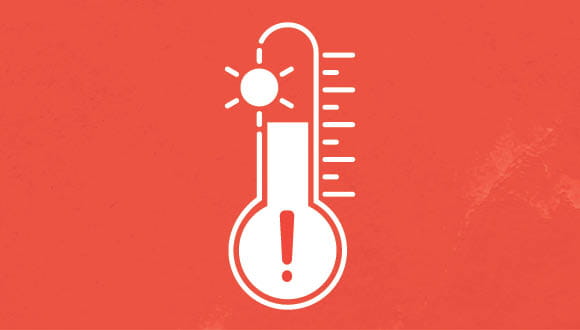8 Ways to Prevent Heat Exhaustion When It's Really Hot Outside
July 15, 2022 - Katie McCallumEvery day can feel like a scorcher during the summer months. And it’s important to take the heat seriously since overheating can pose a risk to your health.
Heat exhaustion, also called heat illness, is when a person's body overheats as a result of exposure to hot weather. You might think this only happens as the result of exercising outside in the heat without proper hydration. But, when it's really hot outside, a person doesn't even have to be exercising to overheat.
Staying safe in the heat is always important. During a heat wave, taking heat safety and heat stroke seriously are more important than ever.
Here are 8 ways to prevent heat exhaustion when it's really hot outside:
1. Avoid becoming dehydrated
Staying properly hydrated can help your body regulate its temperature.
If you need to be outdoors, plan to leave your house already well-hydrated. This doesn't mean just chugging a bunch of water before going outside, by the way — it means drinking plenty of water throughout the day.
It might also mean replenishing the electrolytes you lose as you sweat by sipping on a sports drink, especially if you're a heavy sweater or exercising outdoors.
2. Know that a parked car can be deadly
The temperature outside is hot, and the temperature inside a parked car is even hotter.
According to the CDC, it only takes 10 minutes for the temperature of a car parked in the sun to increase by almost 20 degrees, even with the windows cracked. Avoid being in a hot car, and never leave children or animals in one — even if its is in the shade and the windows are cracked.
3. Dress for the heat (and humidity)
When it's hot, it's important to dress light. Tight-fitting clothes and layered clothing can make it harder for sweat to evaporate from your body — resulting in less efficient release of excess body heat. (Related: How Sweating Works)
Humidity also affects your ability to sweat, so if it's hot and humid, consider wearing moisture-wicking fabrics.
For extra protection from the sun that doesn't increase your chance of overheating, consider wearing a wide-brimmed hat and lathering on plenty of sweat-resistant sunscreen.
4. Seek air conditioning or shade as often as possible
After being cooped up inside all day, getting outdoors can be a great reprieve. But, when it's really hot, you may considering staying indoors during the hottest parts of the day.
If you plan to spend time outside, and particularly if you work outdoors, be sure to take frequent breaks that include time to rehydrate and cool down in the shade.
5. Exercise indoors or early in the morning
Strenuous activity can make it even easier to overheat on a hot, humid day. (Related: 5 Questions to Ask Before Running in Humidity)
So, you may want to consider switching to workouts you can do indoors. Don't have a gym membership? No problem. There are plenty of ways to get a good workout in when you're stuck at home.
If your workout requires being outside, set your alarm and plan for an early morning workout. While you may be tempted into thinking that an evening run is okay, know that the evenings often don't cool down as much as you'd expect during a heat wave.
6. Rethink those outdoor day-drinking plans
Alcohol does more than impair your motor skills and judgement, it can also impair your body's ability to regulate your temperature. In fact, the CDC states that, "drinking alcohol within 24 hours of working in the heat can increase the risk of heat illness."
It's always best to limit alcohol intake. But, when it's really hot outside and you're out in the heat, this becomes even more important. Rehydrate with water, not alcohol.
7. Opt for sweat-resistant sunscreen
Wearing sunscreen while outside is always important — even when it's not hot and even if it's cloudy. But, when it's really hot outside, you'll want to be sure you're wearing the right kind of sunscreen.
Since the heat increases the chance you'll sweat, choose a sunscreen that's sweat resistant. These are often labeled as "Sport" on the bottle. And remember, sunscreen wears off, so you'll need to reapply your sunscreen as indicated on the bottle, as well as after toweling off due to heavy sweating or being in the water.
(Related: Is Spray Sunscreen Effective?)
8. Know the signs of heat exhaustion and when to seek emergency care
During times of extreme heat, anyone who is outside and active during the day is at risk for overheating to the point of developing heat illness.
According to the CDC, heat exhaustion can involve symptoms such as:
- Weakness
- Cramps
- Nausea and vomiting
- Headache
- Fainting
If steps aren't taken to reduce overheating, heat exhaustion can progress to heat stroke — the most severe form of heat illness. It's a life-threatening condition that can damage the brain and other vital organs, making heat stroke a medical emergency that requires immediate treatment in an emergency room. If you or someone you love is showing signs of heat stroke, call 911 immediately.
The most common symptoms of heat stroke include:
- A body temperature of 104 degrees Fahrenheit or higher, as measured by a rectal thermometer
- Sudden confusion or hallucinations
- Difficulty walking
- Seizures
- Fainting
In addition, people suffering heat stroke may also experience racing heart rate, rapid breathing, overly warm skin or skin redness, vomiting or diarrhea, muscle cramps and weakness, and throbbing headaches.








